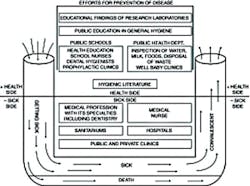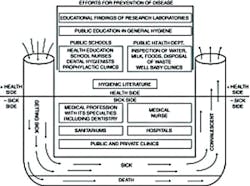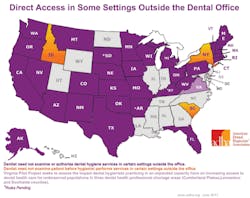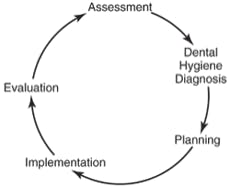The other professionals
How dental hygienists are in a position to work within a health-care team
by Christine Nathe, RDH, MS
Although many students enter dental hygiene school intending to work in a private dental office, many dental hygienists think about pursuing different options at some point in their careers. Their reasons vary, but some may want to try something different, while others may try to create a dental hygiene position in a unique practice setting because of the saturation of dental hygienists and no likely job prospects. Some hygienists may be interested in helping those with underserved dental needs, and some may have their interest sparked by a mentor who had a unique experience.
Although history reveals the dental hygiene profession was actually created to work within multidisciplinary teams, most dental hygienists work within a traditional dental team. Fortunately for dental hygienists, the public, government agencies, other health-care professionals, as well as the dental hygiene profession itself are all showing significant interest in establishing dental hygiene positions in settings other than private dental offices. Not all people are able or willing to visit a dentist’s office. Some may have difficulty accessing dental care, while others may not value dental care enough to visit regularly. This article focuses on dental hygienists working with other professionals as part of a multidisciplinary health-care team to create positions.
Historical perspective
Dental hygiene was founded as a public health profession to work within a multidisciplinary team of professionals to prevent disease and promote health. Dr. Alfred Fones founded the dental hygiene profession in 1913. Dr. Fones envisioned dental hygienists working collaboratively with other health and social service workers to provide preventive health care to the public.
He stated, “Dental hygiene … opens up paths of usefulness, activity and inspiration hitherto undreamed of, allying her with the workers of the world who are helping humanity in masses.” The first dental hygiene graduates became employed in the Bridgeport public schools, and others worked to create positions in hospitals and factories in Connecticut.
Dr. Fones saw dental hygiene as a distinct profession and thought it should be positioned within dental public health, as opposed to being offered only in private dental practices. He positioned dental hygienists to work within an existing system to provide preventive dental health care with a variety of different disciplines (see Figure 1).
He believed that the dental hygienist should provide education and treatment outside of the dental office, where the population was easily accessed, with particular focus on prevention. He emphasized the use of dental hygienists as outreach workers who would bring patients in need of restorative dental care to private dental practices.
In the past in most areas of the country, dental hygienists were restricted to providing care in dental offices. Dental practice laws are changing, and most states now permit the practice of dental hygiene in alternative settings, allowing dental hygienists to work more effectively in the public health arena (see Figure 2) Some states permit dental hygienists to provide direct services to patients in all settings, and they are increasingly bringing dental hygiene services to school children, the elderly, and other underserved populations. For dental hygienists wishing to try something different, these are great populations to focus position-building efforts.
Dental hygiene careers
Many reports suggest an abundance of dental hygienists nationwide, and many dental hygienists report a saturation of the dental hygiene job market. Added to this saturation is the opening of numerous dental hygiene educational programs in proprietary schools, which increases the likelihood of long-term employment challenges for dental hygienists. This increases the need for dental hygienists to create more dental hygiene positions within existing health-care teams in unique settings.
The values Americans place on dental health is increasing, and the proliferation of dental hygienists in dental offices and other health-care facilities is evidence of this change. The insurance industry’s comprehensive coverage of dental hygiene services is more proof that prevention is valued as necessary and logical in health-care delivery. Most would agree that the American public places great value on a healthy, beautiful smile, and Americans are often portrayed as a dentally healthy culture with an emphasis on straight, white teeth. Dental hygienists need to capitalize on these values by increasing access to dental hygiene services by creating new avenues to deliver dental hygiene care.
Creating a team
To establish a dental hygiene position within a multidisciplinary team, the dental hygienist should follow the dental hygiene process of care when developing a proposed position. It is important to identify the various aspects using the dental hygiene process of care (See Figure 3) that an alternative delivery of dental hygiene care entails, and to establish the parameters for setting up such a dental hygiene position.
The dental hygienist should conduct a thorough needs assessment of the population and the existing team serving this population, and any resources available. Does this population have access to dental care, or access to medical care? Could the dental hygienist integrate services into an existing organization? A dental hygienist should never underestimate the importance of understanding if organizations value dental hygiene. What are the missions and goals of the organization and how can dental hygiene complement these missions and goals?
Next, the dental hygienist should develop a comprehensive dental hygiene diagnosis for the target population. The planning stage requires prioritizing goals and objectives and developing a plan. The creation of a detailed written proposal and a presentation geared to the stakeholders and decision makers is important. If accepted, the dental hygienist is ready to operate in this team during the implementation stage. During implementation, the dental hygienist should effectively manage the program, which entails dealing with people in collaborative and supervisory roles.
The evaluative stage includes measuring the intended outcomes and possible revisions to the program. Measurement is obtained through dental indexes, records, and surveys. Moreover, departments within the organization may be very helpful at providing information concerning unmet needs.
Dental care is frequently managed on a case-by-case business-type basis and has not been effectively positioned as comprehensive health care, nor practiced in a multidisciplinary fashion. Dental hygiene must take a look back at its beginnings. Dental hygiene initially had a strong foundation in managing dental care delivery. In fact, dental hygienists were created to intercept dental infections before they became too severe, to refer patients to appropriate health-care providers as needed, and to prevent dental disease in all populations.
Dental hygienists are in a unique position to provide the link to comprehensive oral health care. Dental hygienists interested in working in a unique practice setting should strive to assess needs and develop a plan for implementing a position within an organization that has similar objectives. Because society is demanding a more appropriate delivery system for dental hygiene services, and traditional dental hygiene positions in dental offices are not as abundant as they have been, this is the prime time to investigate new possibilities.
Christine Nathe, RDH, MS, is a professor and graduate program director at the University of New Mexico, Division of Dental Hygiene.
Past RDH Issues



